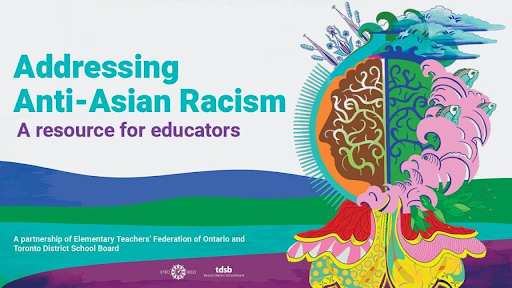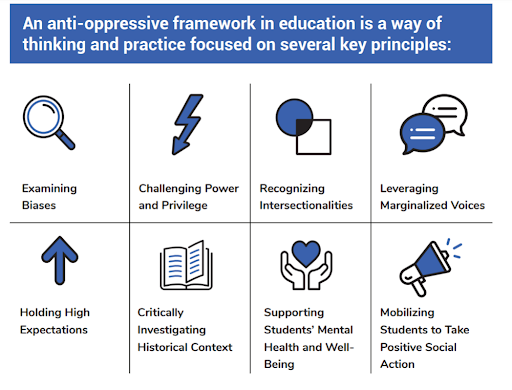In this blog post Stella Kim, one of the co-writers of “Addressing Anti-Asian Racism: A Resource for Educators” and Toronto District School Board secondary science and physics teacher, shares about the process of creating this resource and how you and your colleagues can use this resource for professional learning.
Anti-Asian racism isn’t new. It has deep, historic and political roots in Canada. The outbreak of COVID-19 has prompted a spike in racist aggressions and violence towards peoples of Asian descent, impacting the health and well being of students, educators and communities.
In the summer of 2020, during the post-first wave lull of a global pandemic, I and a team of writers from ETFO and TDSB connected to talk about anti-Asian racism. Our collaboration would become the document, “Addressing Anti-Asian Racism: A Resource for Educators”.
Our hope for this resource
From its inception, the resource was intended to be comprehensive, laying out background knowledge, issues and frameworks, and then leading into a tool kit of ideas and resources for leaders and educators. Along the way, we would discuss important ideas, such as the breadth and diversity of Asian identity, the necessity of centering Indigeneity and Black lives in discussions of racism, the myth of the model minority (pg. 19-21), white supremacy and privilege, intersectional identities and allyship, and lateral violence (intra-community and inter-community violence). Our focus would be on anti-Asian racism and xenophobia experienced by East Asian, South Asian and South East Asian identities. This is with the recognition that the racial discrimination and bigotry faced by communities from Central and Western Asia may be more uniquely and appropriately taken up in focused spaces of antisemitism, Islamophobia, anti-Middle Eastern racism and anti-Arab discrimination.
Identity & Self-Reflection as a Writing Tool
For the writers, all of whom identify as Asian, this project sparked deep self-reflection about who we are and how our families arrived to Canada. For me it was startling to re-examine my personal history in the context of the topics I was tasked to write - for example centering Indigeneity and Black lives, and white supremacy and privilege. Many of us ended up deciding to share a personal anecdote or weave in a narrative as we wrote. I think we hoped that, by sharing personal examples, we might authentically connect with the reader about an under-discussed, often unrecognized and unchecked form of racism. Racism is dehumanizing, while stories provide one of the most human ways we know to connect with and understand each other.
Engaging with the Resource
As a team, our goal was to create a document for educators and schools that expands awareness, invites deeper exploration, and promotes action. The ways in which groups and teams have chosen to engage have varied. One group approached the text book club style, reading a quarter each week for a month and meeting to discuss. Another paced through the document over an eight day e-module that ended with a personal reflection and action plan.
How to Engage with this Resource as a Professional Learning Tool
Below I’ve outlined a sequence of topics groups might use to engage with the issue, along with references from the resource to use as a starting point and guide. Each section of the resource includes “Questions to consider” which can be used to generate discussion and a list of references for additional information.
Before you begin, it is beneficial to reflect on your own identity and your relationship to the issue. You may also wish to reflect on students’ or educators’ responses. Asian peoples came to Canada in many waves over time, in many ways, as indentured labourers, refugees, undocumented, transnational adoptees, sponsored immigrants, by way of other nations, and more. The perspectives and experiences of Asian identity are as varied as their journeys.
Consider approaching the topic as three to four conversations, as outlined below.
*Please note that all page numbers below correspond to the page numbers on the document itself and not the PDF preview.
- Current and historical contexts of anti-Asian racism
Asian people make up almost half of the immigrant population in Canada. Most live in large urban centers, such as Toronto. About half of students in the Toronto District School Board’s population self-identify as Asian. Asian people have a long history in Canada, almost as long as European settlers, yet important events and aspects of historical or contemporary Canadian life often fail to include celebrations of Asian Canadians' success, or details about their struggle. Black and Indigenous scholars, and the Truth and Reconciliation Calls to Action underscore the importance of understanding contemporary issues by knowing history. Students understand this too. Understanding the current contexts of anti-Asian racism today is no different.
Related sections: Asian Canadian Identities and Historical Context, Pg. 8-18
- Centering Black lives and Indigenous voices
Anti-Asian racism is better understood and challenged when Black lives and Indigenous voices are centered. Anti-Black racism, anti-Indigenous racism, and anti-Asian racism are connected, because all oppressions are connected. While distinct, with unique histories and significantly different impacts, all are products of the historic white colonial system that founded Canada. Touching on these broader contexts and histories helps to understand manifestations of anti-Asian racism including the myth of the model minority and lateral violence within and between communities.
Related sections: Centring Indigeneity and Black Lives, Pg. 22-29; White Supremacy and Privilege, Pg. 30-40; Intersectional Identities and Allyship, Pg. 49-52.
- Issues within anti-Asian racism: A model minority, but forever a foreigner
Educators appreciate the opportunity to dig into a specific issue, and the notion of the “the model minority” offers a lot to discuss, especially when paired alongside the “forever foreigner” concept. When Asians aren’t being portrayed as apolitical, uncomplaining, hardworking and successful, they are depicted as dangerous and threatening, taking away resources, and a spreading “yellow peril”. Stereotypes blur and flatten the realities of Asian communities. Asian populations in Canada experience poverty at a rate two to three times higher than White populations. In Toronto schools, while Asian students perform as well or better academically on average, Asian students also report more challenges with mental health.
Related sections: Myth of the Model Minority, Pg. 19-21
- Tools to interrupt anti-Asian racism, including building coalitions and solidarities in anti-racism movements
“Having a diverse school population alone does not shift fundamental power dynamics that enable racism to exist in society.” (Pg. 4)
Ending on a note of planning for action is important, especially when closing this exploration of oppression. While discussions on how to challenge individual and systemic discrimination will look different from group to group, every group benefits from talking about ways to counter narratives as they arise. While awareness building is different from eliminating racism, there is still much value in sharing the long history of solidarities in anti-racism movements, such as between the Asian and Black communities as it interrupts stereotypes and challenges lateral violence. Teams of educators can engage with frameworks such as culturally relevant and responsive pedagogy and the anti-oppressive learning environment framework shared in Section Three and the community, political and education resources in Section Four.
Related sections: Anti-Oppressive Framework and Culturally Relevant and Responsive Pedagogy, Pg. 41-48.
See also: Section Three: School Leaders and Educators’ Toolkit, Pg. 56-77; and Section Four: Where to Next? Resources, Pg. 78-86
It’s been over a year and a half since we sat down to write as a team. The pandemic has continued to disproportionately impact communities of people of colour, and exacerbate inequities including experiences of anti-Asian racism. As you consider how you will move forward to engage with this resource and this issue, consider how identity and community are central to child and youth development. Identity and community are a source of strength. For communities disproportionately impacted by racism, violence and COVID-19, it is healing to hear others, especially those in positions of authority, acknowledge their experiences of oppression and call for collective action towards creating a more just and equitable world.



